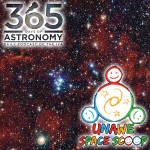Podcaster: Richard Drumm
 Title: Space Scoop: Stellar Families Drift Apart Forever Blowing Superbubbles
Title: Space Scoop: Stellar Families Drift Apart Forever Blowing Superbubbles
Organization: 365 Days Of Astronomy
Link : astrosphere.org ; http://unawe.org/kids/unawe1531/
Description: Space scoop, news for children.
Bio: Richard Drumm is President of the Charlottesville Astronomical Society and President of 3D – Drumm Digital Design, a video production company with clients such as Kodak, Xerox and GlaxoSmithKline Pharmaceuticals. He was an observer with the UVa Parallax Program at McCormick Observatory in 1981 & 1982. He has found that his greatest passion in life is public outreach astronomy and he pursues it at every opportunity.
Today’s sponsor: This episode of “365 Days of Astronomy” is sponsored by — no one. We still need sponsors for many days in 2015, so please consider sponsoring a day or two. Just click on the “Donate” button on the lower left side of this webpage, or contact us at signup@365daysofastronomy.org.
Transcript:
This is 365 Days of Astronomy. Today we bring you a new episode in our Space Scoop series. This show is produced in collaboration with Universe Awareness, a program that strives to inspire every child with our wonderful cosmos.
Today’s story is…
Stellar Families Drift Apart Forever Blowing Superbubbles
A galaxy is often described as an enormous group of stars. And it’s true, galaxies contain from thousands to millions to billions of stars, along with cosmic dust and lots of other space stuff.
But calling a galaxy a group of stars, even an enormous one, sounds like they’re bundled together like a pile of dirty clothes.
And even though they are bundled together by their gravity, galaxies can be very well organized, with a clear, recognizable shape – more like laundry that’s been neatly folded and put away.
Our galaxy, the Milky Way, is a spiral galaxy. Spiral galaxies are flat discs like a CD. But instead of a hole at the centre, there is a large blob. At the scale of a CD the blob or central bulge is the size of a ping pong ball. And this bulge has a supermassive black hole lurking in its centre!
And of course, spiral galaxies have enormous arms that wind around the centre, like the twirling skirt on a ballroom dancer. Finally, the whole thing is wrapped in a so-called halo of old stars and mysterious, invisible stuff: dark matter, like a bubble.
The picture in today’s album artwork, taken by the Wide Field Imager camera on the VLT, the Very Large Telescope at Paranal Observatory in Chile, shows a group of young stars called an Open Cluster. This cluster is NGC 2367 in the constellation Canis Major and is about 7,000 light years away from Earth.
NGC 2367 was discovered by Sir William Herschel in 1784 and is only 5 million years old. So these are basically baby stars, massive, hot, young blue stars, surrounded by the red glow of hydrogen gas.
The hydrogen gas is the remains of the natal cloud, the cloud from which the cluster was born, ionized and glowing in that red hydrogen-alpha glow caused by the UV light the hot stars are pouring out.
As you look farther out from the cluster, you see more hydrogen gas in a far more expansive structure known as Brand 16, which itself is part of an even larger so-called supershell called GS234-02.
This supershell lies on the outskirts of our galaxy and is a vast structure, spanning hundreds of light years. It began its life when a group of particularly massive stars, producing strong stellar winds, created individual expanding bubbles of hot gas.
These neighbouring bubbles eventually merged to form a superbubble, and the short life spans of the stars at its heart meant that they exploded as supernovae at similar times, expanding the superbubble even further, to the point that it merged with other superbubbles, which is when the supershell was formed. The resulting formation ranks as one of the largest possible structures within a galaxy.
In spiral galaxies, open clusters are normally found in the spiral arms. That’s because this is where you find lots of cosmic gas; the main ingredient for making stars, and open clusters are made of those stars.
Unlike some other groups of stars, the stars in open clusters are only loosely bound to each other and slowly drift apart as they get older, over a few hundred million years, by gravitationally interacting with the other gas & star clusters in the spiral arms.
Actually, our own Sun was probably born in an open cluster with hundreds of siblings that have long since wandered off into space! They could be on the far side of the galaxy from us now, no telling.
Hey Here’s a Cool Fact
Our Galaxy contains around 1,000 open clusters! And these clusters serve as excellent case studies for stellar evolution. All the constituent stars in the cluster are born at roughly the same time from the same cloud of material, meaning they can be compared side-by-side with great ease, allowing their ages to be readily determined and their evolution mapped.
This concentrically expanding system, as ancient as it is enormous, provides a wonderful example of the intricate, interrelated structures that are sculpted in galaxies by the lives and deaths of stars.
Thank you for listening to 365 Days of Astronomy!
End of podcast:
365 Days of Astronomy
=====================
The 365 Days of Astronomy Podcast is produced by NUCLIO. Audio post-production by Richard Drumm. Bandwidth donated by libsyn.com and wizzard media. You may reproduce and distribute this audio for non-commercial purposes. Please consider supporting the podcast with a few dollars (or Euros!). Visit us on the web at 365DaysOfAstronomy.org or email us at info@365DaysOfAstronomy.org. This year we celebrate cosmic light as light is our info messenger in the universe. Join us and share your story to celebrate the International Year of Light. Until tomorrow! Goodbye!

